Use of MODIS Images to Quantify the Radiation and Energy Balances in the Brazilian Pantanal
Abstract
:1. Introduction
2. Material and Methods
2.1. Brazilian Pantanal Characteristics
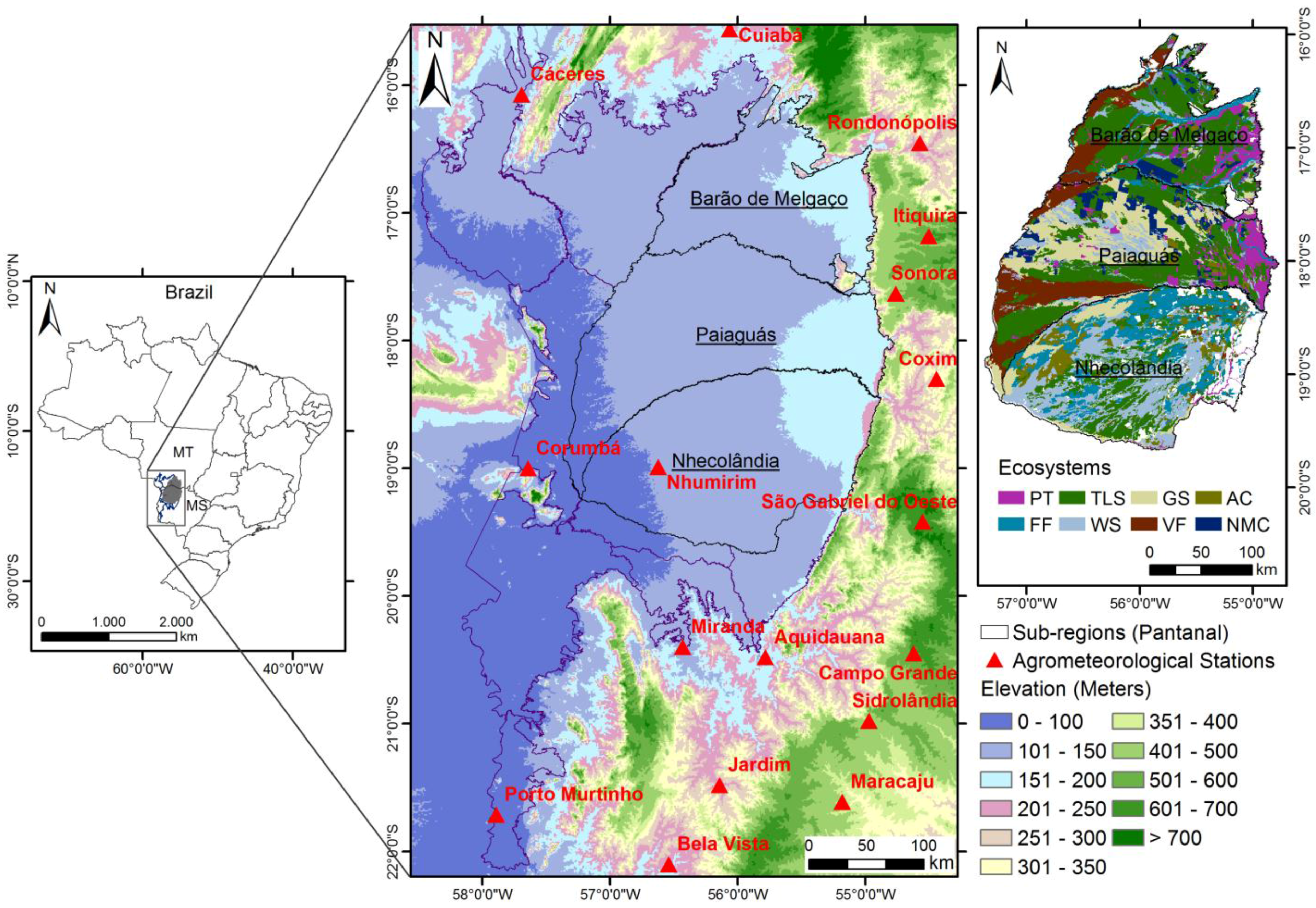
2.2. Modelling the Large-Scale Radiation and Energy Balance Components
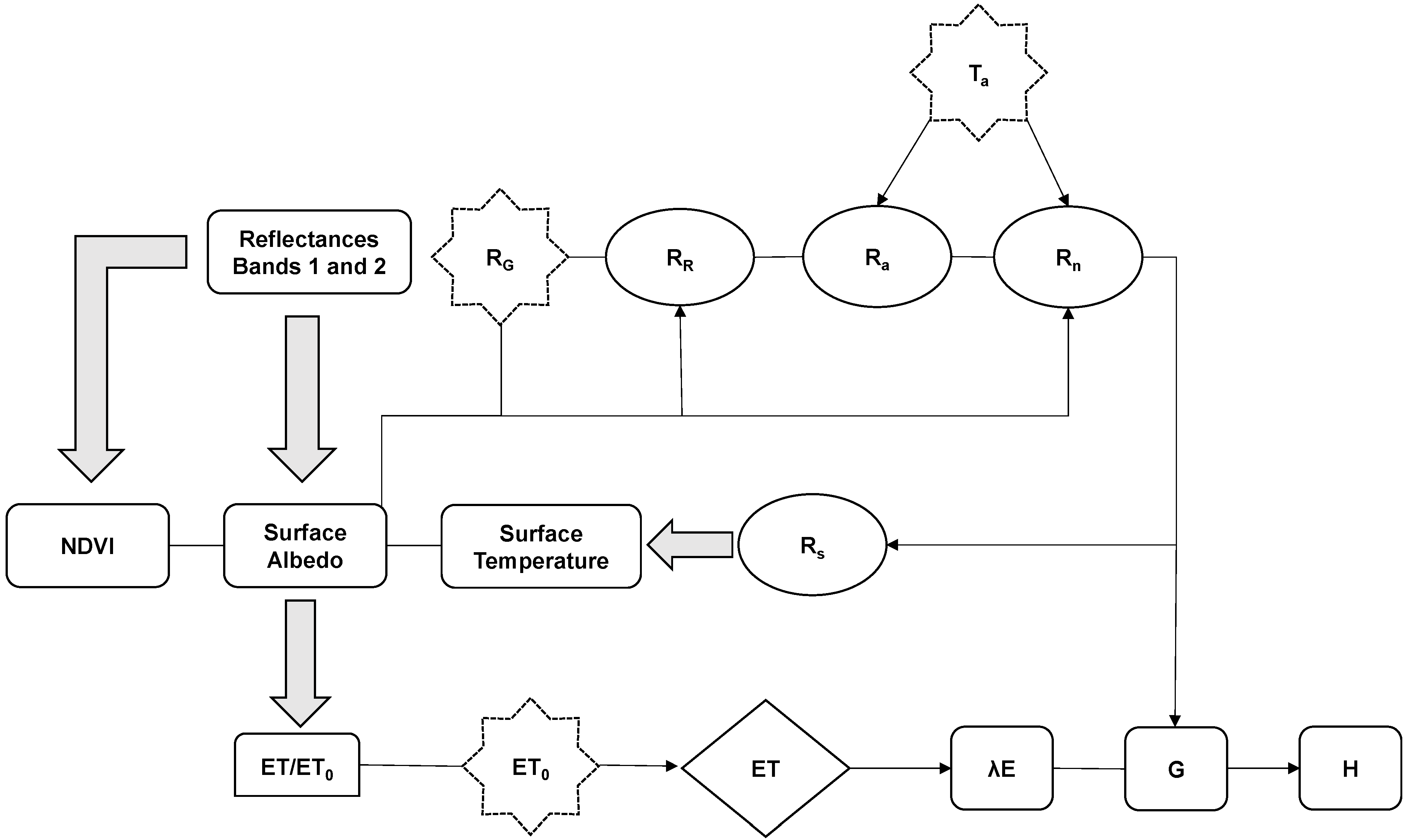
3. Results and Discussion
3.1. Weather Drivers

3.2. Large-Scale Radiation Balance
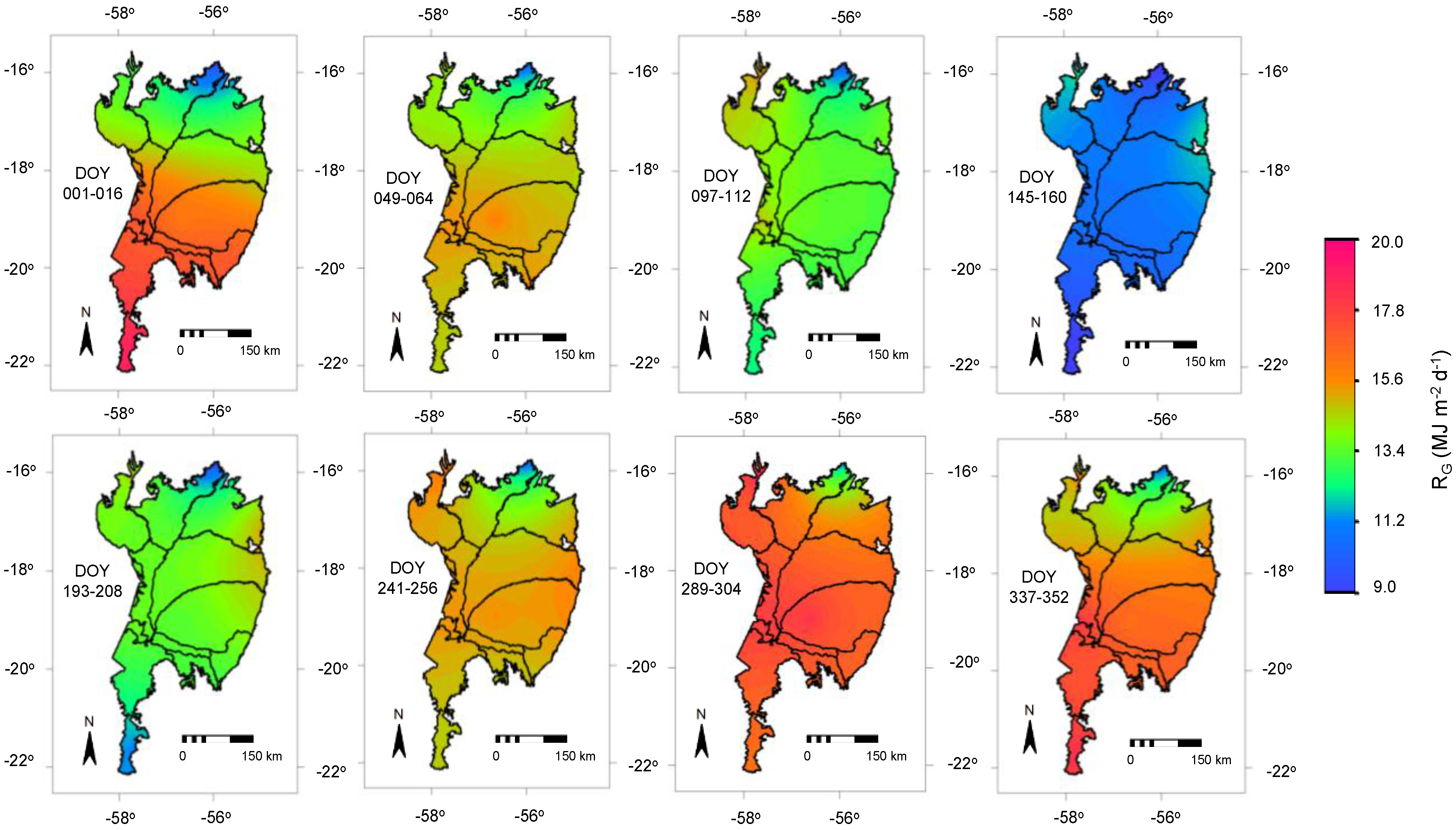

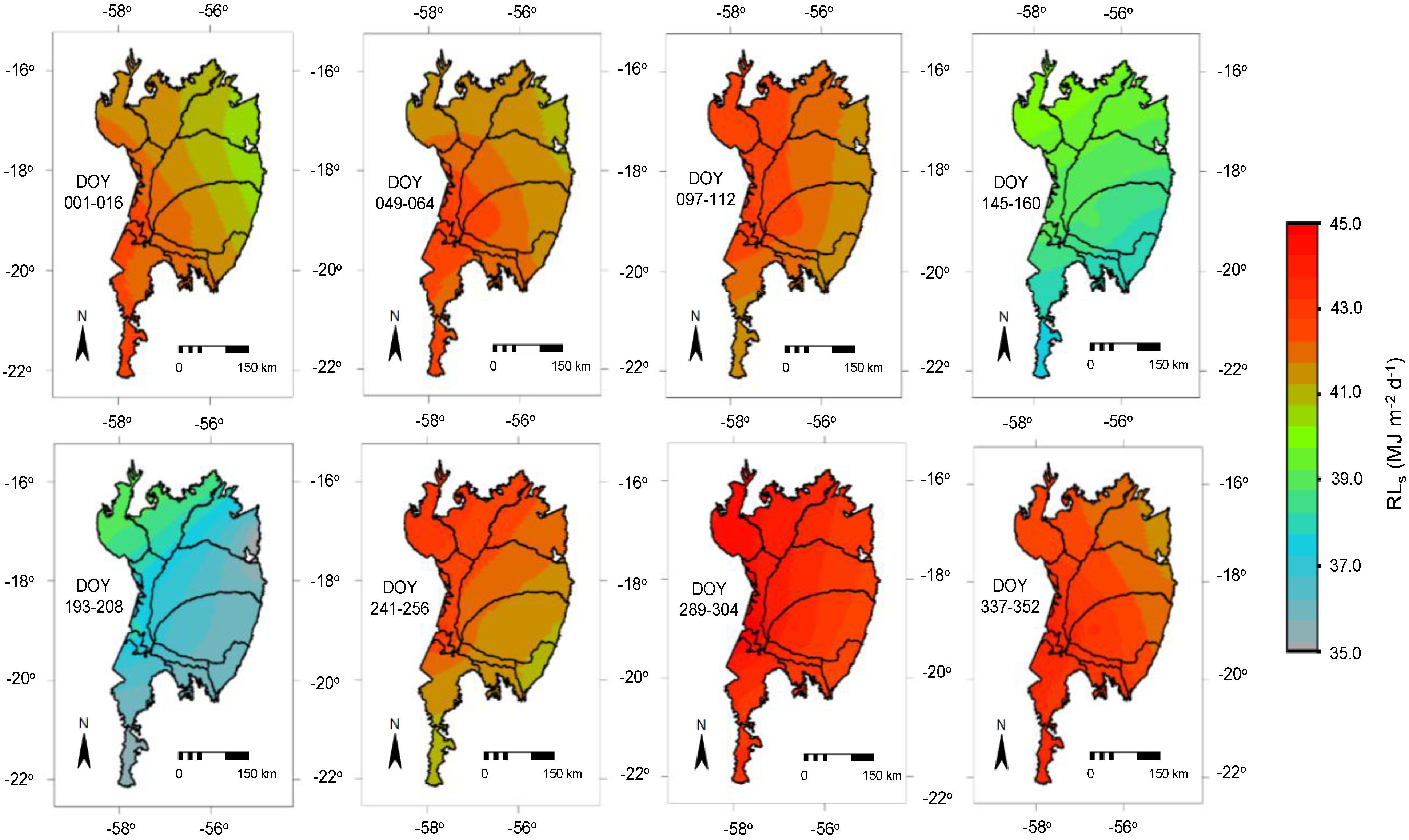
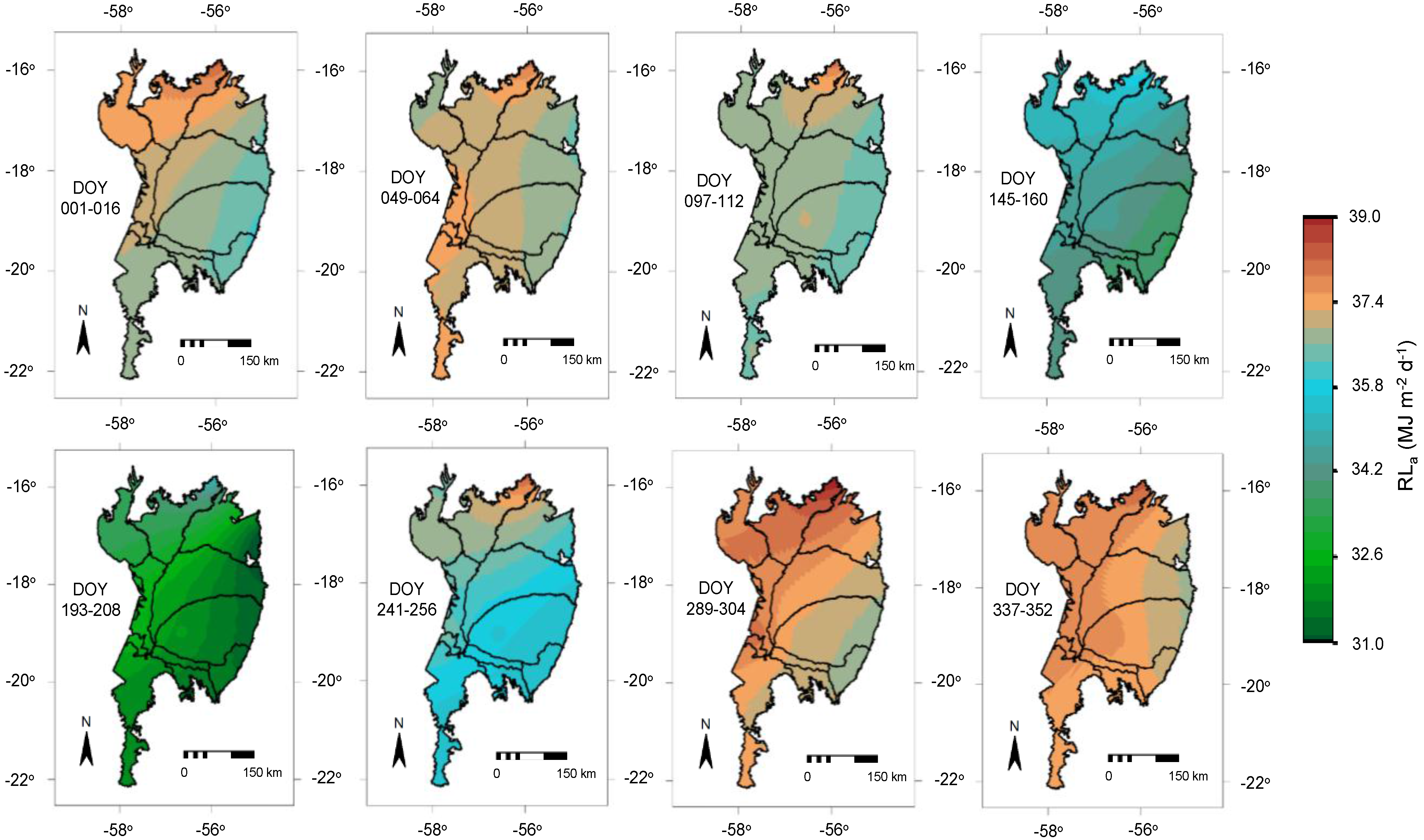
| Quarterly/Year | RG(MJ·m−2·d−1) | RR (MJ·m−2·d−1) | RLa (MJ·m−2·d−1) | RLs (MJ·m−2·d−1) |
|---|---|---|---|---|
| Barão de Melgaço (BR) | ||||
| January–April | 13.52 ± 0.58 | 2.16 ± 0.45 | 36.65 ± 0.27 | 41.11 ± 0.18 |
| May–August | 13.03 ± 0.66 | 2.04 ± 0.20 | 34.32 ± 0.58 | 39.27 ± 0.51 |
| September–December | 14.36 ± 0.57 | 2.32 ± 0.24 | 37.50 ± 0.28 | 42.18 ± 0.19 |
| Year | 13.61 ± 0.60 | 2.17 ± 0.30 | 36.10 ± 0.38 | 40.79 ± 0.30 |
| Paiaguás (PA) | ||||
| January–April | 14.56 ± 0.39 | 2.31 ± 0.21 | 36.48 ± 0.20 | 41.36 ± 0.37 |
| May–August | 13.45 ± 0.38 | 2.09 ± 0.19 | 33.98 ± 0.38 | 39.15 ± 0.43 |
| September–December | 15.32 ± 0.44 | 2.53 ± 0.27 | 37.26 ± 0.23 | 42.41 ± 0.35 |
| Year | 14.40 ± 0.40 | 2.30 ± 0.22 | 35.85 ± 0.27 | 40.91 ± 0.39 |
| Nhecolândia (NH) | ||||
| January–April | 15.11 ± 0.29 | 2.44 ± 0.18 | 36.30 ± 0.20 | 41.36 ± 0.35 |
| May–August | 13.38 ± 0.32 | 2.12 ± 0.16 | 33.74 ± 0.29 | 38.87 ± 0.31 |
| September–December | 15.91 ± 0.27 | 2.67 ± 0.24 | 37.03 ± 0.22 | 42.34 ± 0.35 |
| Year | 14.75 ± 0.29 | 2.40 ± 0.19 | 35.63 ± 0.23 | 40.79 ± 0.33 |
3.3. Large-Scale Energy Balance
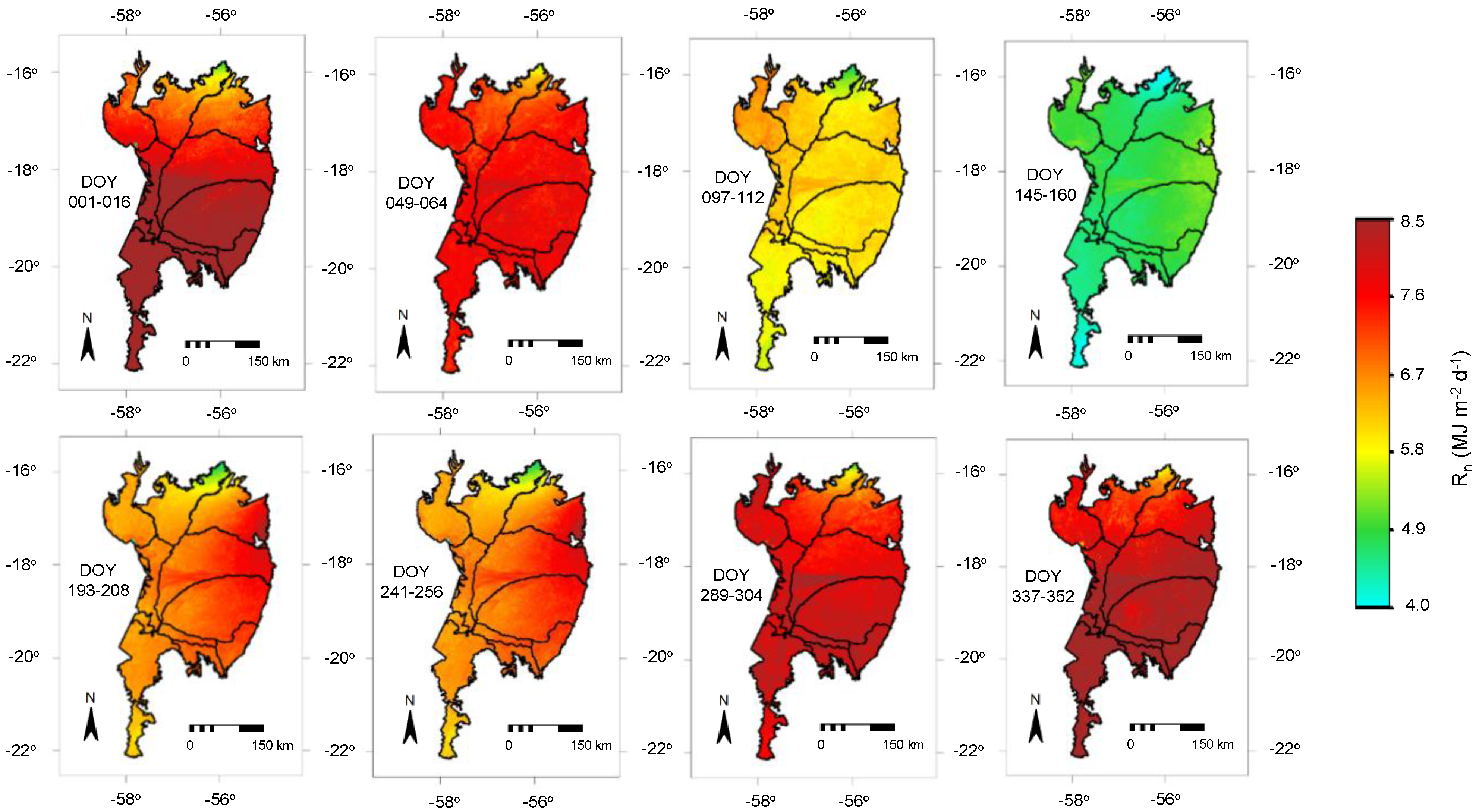
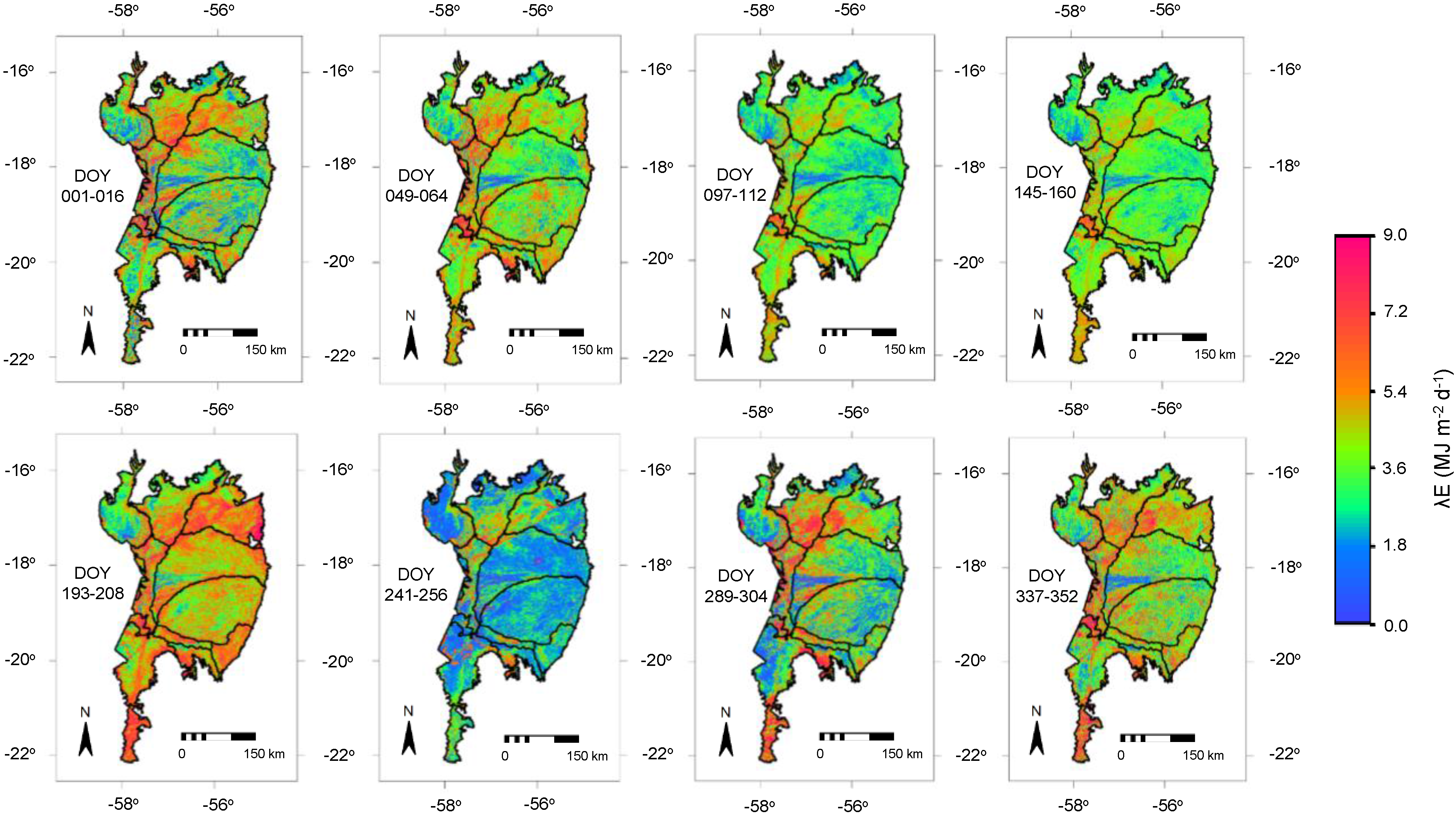
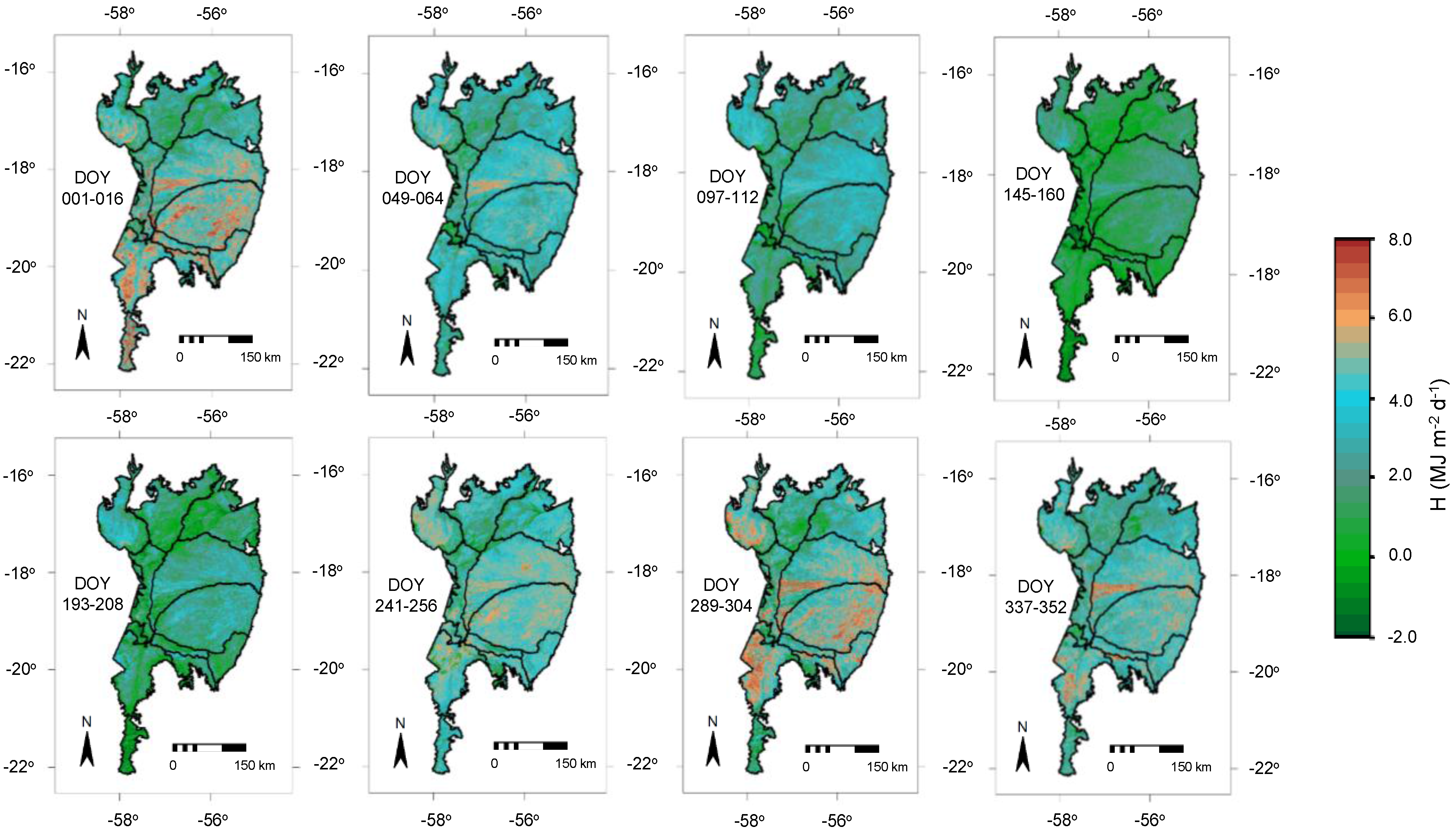
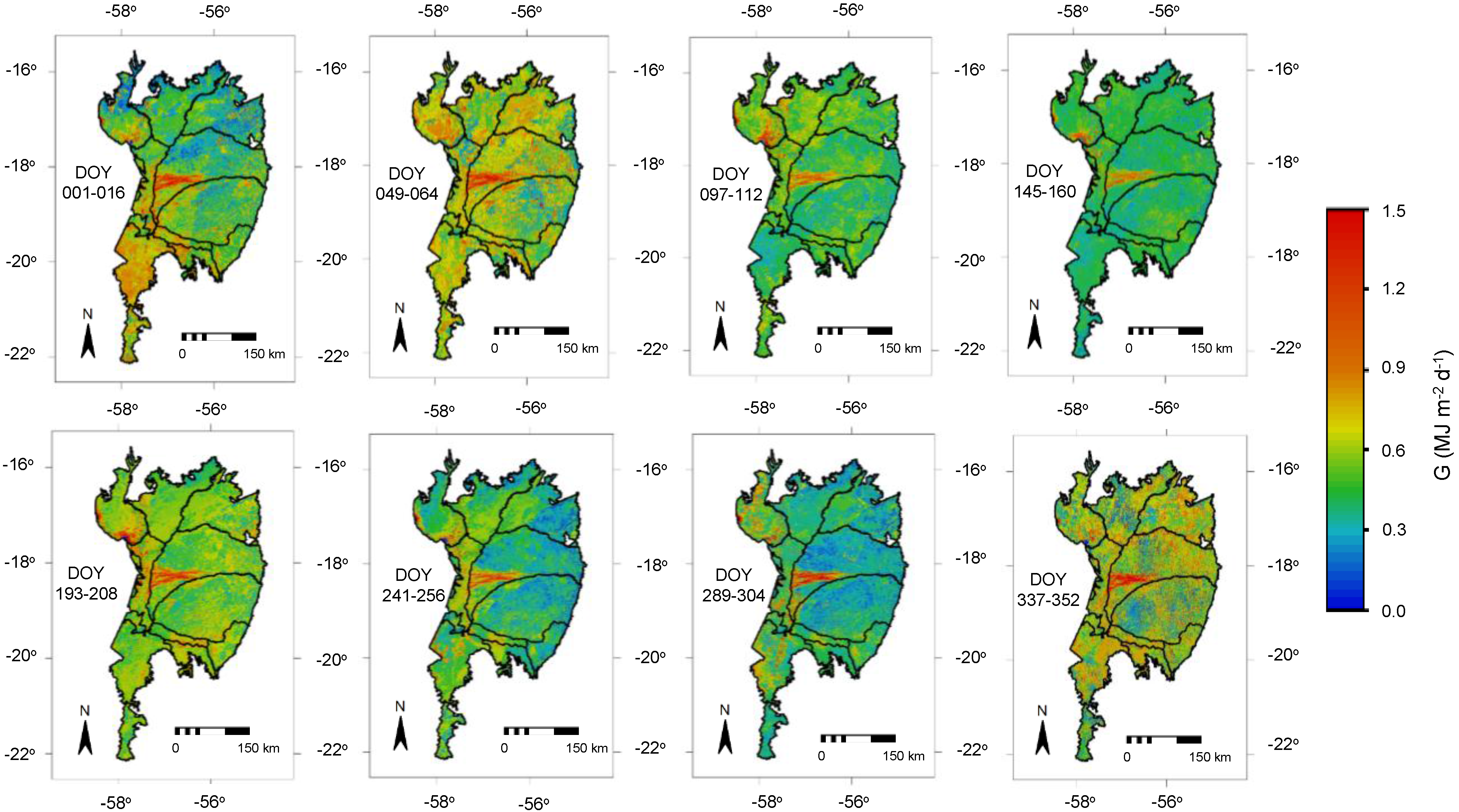
| Quarter/Year | Rn (MJ·m−2·d−1) | λE (MJ·m−2·d−1) | H (MJ·m−2·d−1) | G (MJ·m−2·d−1) |
|---|---|---|---|---|
| Barão de Melgaço (BR) | ||||
| January–April | 6.90 ± 0.34 | 4.04 ± 1.06 | 2.36 ± 1.05 | 0.50 ± 0.16 |
| May–August | 6.04 ± 0.45 | 4.14 ± 1.21 | 1.43 ± 0.95 | 0.48 ± 0.12 |
| September–December | 7.37 ± 0.36 | 3.82 ± 1.31 | 2.77 ± 1.28 | 0.46 ± 0.17 |
| Year | 6.74 ± 0.38 | 4.00 ± 1.19 | 2.16 ± 1.08 | 0.48 ± 0.15 |
| Paiaguás (PA) | ||||
| January–April | 7.37 ± 0.30 | 3.41 ± 1.28 | 3.39 ± 1.23 | 0.57 ± 0.25 |
| May–August | 6.18 ± 0.33 | 3.26 ± 1.08 | 2.42 ± 0.96 | 0.51 ± 0.19 |
| September–December | 7.64 ± 0.35 | 3.15 ± 1.41 | 3.97 ± 1.39 | 0.52 ± 0.29 |
| Year | 7.04 ± 0.33 | 3.27 ± 1.25 | 3.23 ± 1.18 | 0.52 ± 0.24 |
| Nhecolândia (NH) | ||||
| January–April | 7.61 ± 0.23 | 3.51 ± 1.11 | 3.57 ± 1.10 | 0.53 ± 0.18 |
| May–August | 6.13 ± 0.28 | 3.13 ± 0.93 | 2.55 ± 0.89 | 0.46 ± 0.13 |
| September–December | 7.93 ± 0.28 | 3.18 ± 1.23 | 4.27 ± 1.23 | 0.48 ± 0.20 |
| Year | 7.19 ± 0.26 | 3.28 ± 1.08 | 3.43 ± 1.07 | 0.49 ± 0.17 |
3.4. Ecosystem Energy Partitions
| Classes | Rn (MJ·m−2·d−1) | λE (MJ·m−2·d−1) | H (MJ·m−2·d−1) | G (MJ·m−2·d−1) | Ef (-) |
|---|---|---|---|---|---|
| PT | 7.02 ± 0.32 | 3.62 ± 0.88 | 2.81 ± 0.93 | 0.59 ± 0.11 | 0.56 |
| FF | 7.08 ± 0.29 | 3.61 ± 0.97 | 2.83 ± 1.09 | 0.64 ± 0.11 | 0.56 |
| TLS | 6.93 ± 0.33 | 3.64 ± 0.90 | 2.64 ± 1.00 | 0.65 ± 0.11 | 0.58 |
| WS | 7.08 ± 0.28 | 3.23 ± 0.94 | 3.22 ± 1.05 | 0.63 ± 0.12 | 0.50 |
| GS | 6.97 ± 0.22 | 3.39 ± 0.85 | 2.94 ± 0.86 | 0.64 ± 0.11 | 0.54 |
| FV | 6.92 ± 0.46 | 3.43 ± 1.49 | 2.67 ± 1.59 | 0.82 ± 0.21 | 0.56 |
| AC | 7.04 ± 0.26 | 2.99 ± 0.75 | 3.48 ± 0.82 | 0.57 ± 0.10 | 0.46 |
| NMC | 6.81 ± 0.24 | 3.23 ± 0.69 | 3.02 ± 0.76 | 0.56 ± 0.09 | 0.52 |
4. Conclusions
Acknowledgments
Author Contributions
Conflicts of Interest
References
- UNESCO. Ramsar: Convention on Wetlands of International Importance Especially as Waterfowl Habitat 1971. Available online: http://portal.unesco.org/en/ev.php-URL_ID=15398&URL_DO=DO_TOPIC&URL_SECTION=201.html (accessed on 15 July 2015).
- Verhoeven, J.T.A.; Setter, T.L. Agricultural use of wetlands: Opportunities and limitations. Ann. Bot. 2010, 105, 155–163. [Google Scholar] [CrossRef] [PubMed]
- Goulden, M.L.; Litvak, M.; Miller, S.D. Factors that control Typha marsh evapotranspiration. Aquatic Botany 2007, 86, 97–106. [Google Scholar] [CrossRef]
- Junk, W.J.; Cunha, C.N.; Wantzen, K.M.; Petermann, P.; Strüssmann, C.; Marques, M.I.; Adis, J. Biodiversity and its conservation in the Pantanal of Mato Grosso, Brazil. Aquat. Sci. 2006, 68, 278–309. [Google Scholar] [CrossRef]
- Embrapa Pantanal, SOS Pantanal Institute, WWF-Brazil. Monitoramento das alterações da cobertura vegetal e uso da terra na bacia do alto rio Paraguai—Porção Brasileira( período de análise: 2010 a 2012); Embrapa Pantanal: Brasília, Brasil, 2014. [Google Scholar]
- Silva, M.H.S. Caracterização Pedomorfológica e Compreensão dos Processos pedogenéticos dos solos da Lagoa Salitrada: Pantanal de Nhecolândia. Master’s Thesis, Dissertação de Mestrado, Universidade Federal do Mato Grosso do Sul (UFMS/CPAQ), Aquidauana, Mato Grosso do Sul, Brazil, 2007. [Google Scholar]
- Adami, M.; Freitas, R.M.; Padovani, C.R.; Shimabukuro, Y.E.; Moreira, M.A. Estudo da dinâmica espaço-temporal do bioma Pantanal por meio de imagens MODIS. Pesquisa Agropecuária Brasileira 2008, 43, 1371–1378. [Google Scholar] [CrossRef]
- Bispo, R.C.; Petrini, M.A.; Lamparelli, R.A.C.; Rocha, J.V. Supervised classification applied to vegetation in the Barão de Melgaço municipality (Mato Grosso state, Brazil), using MODIS imagery. Geografia 2013, 38, 9–23. [Google Scholar]
- Zhang, Y.; Kadota, T.; Ohata, T.; Oyunbaatar, D. Environmental controls on evapotranspiration from sparse grassland in Mongolia. Hydrol. Process. 2007, 21, 2016–2027. [Google Scholar] [CrossRef]
- Cleugh, H.A.; Leuning, R.; Mu, Q.; Running, S.W. Regional evaporation estimates from flux tower and MODIS satellite data. Remote Sens. Environ. 2007, 106, 285–304. [Google Scholar] [CrossRef]
- Allen, R.G.; Pereira, L.S.; Raes, D.; Smith, M. Crop Evapotranspiration: Guidelines for Computing Crop Water Requirements; Food and Agriculture Organization of the United Nations: Rome, Italy, 1998. [Google Scholar]
- Teixeira, A.H. de C.; Hernandez, F.B.T.; Lopes, H.L.; Scherer-Warren, M.; Bassoi, L.H. A comparative study of techniques for modeling the spatiotemporal distribution of heat and moisture fluxes in different agroecosystems in Brazil. In Remote Sensing of Energy Fluxes and Soil Moisture Content, 1st ed.; Petropoulos, G.P., Ed.; CRC Press, Taylor and Francis Group: Boca Raton, FL, USA, 2014; pp. 169–191. [Google Scholar]
- Oliveira, M.B.L.; Von Randaw, C.; Manzi, A.O.; Alvalá, R.C. dos S.; Sá, L.D. de A.; Leitão, M.V.B.R.; de Souza, A. Fluxos turbulentos de energia sobre o Pantanal sul mato-grossense. Revista Brasileira de Meteorologia 2006, 21, 159–165. [Google Scholar]
- Sanches, L.; Vourlits, G.L.; Alves, M. de C.; Pinto-Júnior, O.B.; Nogueira, J. de S. Seasonal patterns of evapotranspiration for a Vochysiadivergens forest in the Brazilian Pantanal. Wetlands 2011, 31, 1211–1225. [Google Scholar] [CrossRef]
- Curado, L.F.A.; Nogueira, J. de S.; Sanches, L.; Biudes, M.S.; Rodrigues, T.R. Interannual variability of energy flux in atmospheric instability at Pantanal of Mato Grosso-Brazil. Atmos. Clim. Sci. 2012, 2, 518–524. [Google Scholar]
- Galeano, D.C.; Biudes, M.S.; Danelichen, V.H. de M.; Fabian, F.A.; Souza, M.C. Energy balance in a pasture in the Pantanal. J. Biotechnol. Biodivers. 2013, 4, 2179–4874. [Google Scholar]
- Miralles, D.G.; Holmes, T.R.H.; De Jeu, R.A.M.; Gash, J.H.; Meesters, A.G.C.A.; Dolman, A.J. Global land-surface evaporation estimated from satellite-based observations. Hydrol. Earth Syst. Sci. 2011, 15, 453–469. [Google Scholar] [CrossRef]
- Anderson, M.C.; Kustas, W.P.; Alfieri, J.G.; Gao, F.; Hain, C. Mapping daily evapotranspiration at Landsat spatial scales during BEAREX'08 field campaign. Adv. Water Resour. 2012, 50, 162–177. [Google Scholar] [CrossRef]
- Pôças, I.; Cunha, M.; Pereira, L.S.; Allen, R.G. Using remote sensing energy balance and evapotranspiration to characterize montane landscape vegetation with focus on grass and pasture lands. Int. J. Appl. Earth Obs. Geoinf. 2013, 21, 159–172. [Google Scholar] [CrossRef]
- Majumdar, T.J.; Brattacharyya, R.; Chattejee, S. On the utilization of ENVISAT AATSR data for geological/hydrological applications. Acta Astron. 2007, 60, 899–905. [Google Scholar] [CrossRef]
- Bastiaansssen, W.G.M.; Menenti, M.; Feddes, R.A.; Roerink, G.J.; Holtslag, A.A.M. A remote sensing surface energy balance algorithm for land (SEBAL) 1. Formulation. J. Hydrol. 1998, 212–213, 198–212. [Google Scholar] [CrossRef]
- Roerink, G.J.; Su, Z.; Menenti, M. S-SEBI: A simple remote sensing algorithm to estimate the surface energy balance. Phys. Chem. Earth 2000, 25, 147–157. [Google Scholar] [CrossRef]
- Su, Z. The Surface Energy Balance System (SEBS) for estimation of turbulent heat fluxes. Hydrol. Earth Syst. Sci. 2002, 6, 85–99. [Google Scholar] [CrossRef]
- Teixeira, A.H. de C.; Bastiaanssen, W.G.M.; Ahmad, M.D.; Bos, M.G. Reviewing SEBAL input parameters for assessing evapotranspiration and water productivity for the Low-Middle São Francisco River basin, Brazil Part A: Calibration and validation. Agric. For. Meteorol. 2009, 149, 462–476. [Google Scholar] [CrossRef] [Green Version]
- Andrade, R.G.; Sediyama, G.C.; da Paz, A.R.; Lima, E. de P.; Facco, A.G. Geotecnologias aplicadas à avaliação de parâmetros biofísicos do Pantanal. Pesquisa Agropecuária Brasileira 2012, 47, 1227–1234. [Google Scholar] [CrossRef]
- Nagler, P.L.; Glenn, E.P.; Nguyen, U.; Scott, R.L.; Doody, T. Estimating riparian and agricultural actual evapotranspiration by reference evapotranspiration and MODIS enhanced vegetation index. Remote Sens. 2013, 5, 3849–3871. [Google Scholar] [CrossRef]
- Kamble, B.; Kilic, A.; Hubard, K. Estimating crop coefficients using remote sensing-based vegetation index. Remote Sens. 2013, 5, 1588–1602. [Google Scholar] [CrossRef]
- Allen, R.G.; Tasumi, M.; Morse, A.; Trezza, R.; Wright, J.L.; Bastiaanssen, W.G.M.; Kramber, W.; Lorite, I.; Robison, C.W. Satellite-based energy balance for mapping evapotranspiration with internalized calibration (METRIC)—Applications. J. Irrig. Drain. Eng. 2007, 133, 395–406. [Google Scholar] [CrossRef]
- Teixeira, A.H. de C. Determining regional actual evapotranspiration of irrigated and natural vegetation in the São Francisco river basin (Brazil) using remote sensing and Penman-Monteith equation. Remote Sens. 2010, 2, 1287–1319. [Google Scholar] [CrossRef]
- Suzuki, T.; Takeshi Ohta, T.; Hiyama, T.; Izumi, Y.; Mwandemele, O.; Iijima, M. Effects of the introduction of rice on evapotranspiration in seasonal wetlands. Hydrol. Process. 2014, 28, 4780–4794. [Google Scholar] [CrossRef]
- Teixeira, A.H. de C.; Bastiaanssen, W.G.M.; Ahmad, M.D.; Bos, M.G.; Moura, M.S.B. Analysis of energy fluxes and vegetation-atmosphere parameters in irrigated and natural ecosystems of semi-arid Brazil. J. Hydrol. 2008, 362, 110–127. [Google Scholar] [CrossRef]
- Teixeira, A.H. de C.; Scherer-Warren, M.; Hernandez, F.B.T.; Andrade, R.G.; Leivas, J.F. Large-scale water productivity assessments with MODIS images in a changing semi-arid environment: A Brazilian case study. Remote Sens. 2013, 11, 5783–5804. [Google Scholar]
- Valiente, J.A.; Nunez, M.; Lopez-Baeza, E.; Moreno, J.F. Narrow-band to broad-band conversion for Meteosat visible channel and broad-band albedo using both AVHRR-1 and -2 channels. Int. J. Remote Sens. 1995, 16, 1147–1166. [Google Scholar] [CrossRef]
- Teixeira, A.H. de C.; Victoria, D. de C.; Andrade, R.G.; Leivas, J.F.; Bolfe, E.L.; Cruz, C.R. Coupling MODIS images and agrometeorological data for agricultural water productivity analyses in the Mato Grosso state, Brazil. Proc. SPIE 2014. [Google Scholar] [CrossRef]
- Teixeira, A.H. de C.; Hernandez, F.B.T.; Andrade, R.G.; Leivas, J.F.; Bolfe, E.L. Energy balance with Landsat images in irrigated central pivots with corn crop in the São Paulo State, Brazil. Proc. SPIE 2014. [Google Scholar] [CrossRef]
- Allen, R.G.; Hartogensis, O.; de Bruin, H.A.R. Long-Wave Radiation over Alfafa During the RAPID Field Campaign in Southern Idaho; Research Report; Univ. of Idaho: Kimberly, ID, USA, 2000. [Google Scholar]
- Raupasch, M.R. Combination theory and equilibrium evaporation. Quart. J. R. Meteorol. Soc. 2001, 127, 1149–1181. [Google Scholar] [CrossRef]
- Monteith, J.L.; Unsworth, M.H. Principles of Environmental Physics; Arnold: London, UK, 1990. [Google Scholar]
- Oguntoyinbo, J.S. Reflection coefficient of natural vegetation, crops and urban surfaces in Nigeria. Quart. J. R. Meteorol. Soc. 1970, 96, 430–441. [Google Scholar] [CrossRef]
- Pinker, R.T.; Thompson, O.E.; Eck, T.F. The albedo of a tropical evergreen forest. Quart. J. R. Meteorol. Soc. 1980, 106, 551–558. [Google Scholar] [CrossRef]
- Shuttleworth, W.J. Evaporation from Amazonian rain forest. Proc. R. Soc. Lond. B, Biol. Sci. 1988, 233, 321–346. [Google Scholar] [CrossRef]
- Lobell, D.B.; Asner, G.P. Moisture effects on soil reflectance. Soil Sci. Soc. Am. J. 2002, 66, 722–727. [Google Scholar] [CrossRef]
- Van Dijk, A.I.J.M.; Bruijnzeel, L.A.; Schellekens, J. Micrometeorology and water use of mixed crops in upland West Java, Indonesia. Agric. For. Meteorol. 2004, 124, 31–49. [Google Scholar] [CrossRef]
- Li, S.-G.; Eugster, W.; Asanuma, J.; Kotani, A.; Davaa, G.; Oyunbaatar, D.; Sugita, M. Energy partitioning and its biophysical controls above a grazing steppe in central Mongolia. Agric. For. Meteorol. 2006, 137, 89–106. [Google Scholar] [CrossRef]
- Hughes, C.E.; Kalma, J.D.; Binning, P.; Willgoose, G.R.; Vertzonis, M. Estimating evapotranspiration for a temperate salt marsh Newcastle, Australia. Hydrol. Process. 2001, 15, 957–975. [Google Scholar] [CrossRef]
- Moraes, E.C.; Pereira, G.; Cardoso, F. da S. Evaluation of reduction of Pantanal wetlands in 2012. Geografia 2013, 38, 81–93. [Google Scholar]
© 2015 by the authors; licensee MDPI, Basel, Switzerland. This article is an open access article distributed under the terms and conditions of the Creative Commons Attribution license (http://creativecommons.org/licenses/by/4.0/).
Share and Cite
Teixeira, A.H.d.C.; Padovani, C.R.; Andrade, R.G.; Leivas, J.F.; Victoria, D.D.C.; Galdino, S. Use of MODIS Images to Quantify the Radiation and Energy Balances in the Brazilian Pantanal. Remote Sens. 2015, 7, 14597-14619. https://doi.org/10.3390/rs71114597
Teixeira AHdC, Padovani CR, Andrade RG, Leivas JF, Victoria DDC, Galdino S. Use of MODIS Images to Quantify the Radiation and Energy Balances in the Brazilian Pantanal. Remote Sensing. 2015; 7(11):14597-14619. https://doi.org/10.3390/rs71114597
Chicago/Turabian StyleTeixeira, Antônio H. de C., Carlos R. Padovani, Ricardo G. Andrade, Janice F. Leivas, Daniel De C. Victoria, and Sergio Galdino. 2015. "Use of MODIS Images to Quantify the Radiation and Energy Balances in the Brazilian Pantanal" Remote Sensing 7, no. 11: 14597-14619. https://doi.org/10.3390/rs71114597






